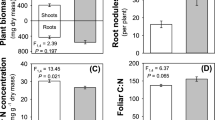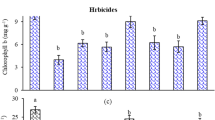Abstract
Many observations have been made of increased population densities of herbivorous insects in areas subject to air pollution1–3. However, in the absence of experimental investigations, the significance of most of these observations is not clear and any underlying causal mechanisms remain obscure. The only published studies designed to investigate experimentally the impact of pollutants on plant–herbivore systems involve fumigations with either hydrogen fluoride (HF)4 or sulphur dioxide (SO2)5,6 of Phaseolus vulgaris and Glycine max plants, infested with the Mexican bean beetle, Epilachna varivestis: in general the results showed that HF reduced beetle performance whereas SO2 stimulated it, but the relative importance of direct and indirect effects of the pollutants was not elucidated. We show here stimulatory effects of SO2 and NO2 and ambient London air on the growth of the black bean aphid, Aphis fabae, and demonstrate that these have been mediated entirely via the host plant.
This is a preview of subscription content, access via your institution
Access options
Subscribe to this journal
Receive 51 print issues and online access
$199.00 per year
only $3.90 per issue
Buy this article
- Purchase on Springer Link
- Instant access to full article PDF
Prices may be subject to local taxes which are calculated during checkout
Similar content being viewed by others
References
Wiackowski, S. K. Folia for. pol. A23, 175–187 (1978).
Port, G. R. & Thompson, J. R. J. appl. Ecol. 17, 649–656 (1980).
Villemont, C. Envir. Pollut. A24, 245–262 (1981).
Weinstein, L. H. J. occup. Med. 19, 49–78 (1977).
Hughes, P. R., Potter, J. E. & Weinstein, L. H. Envir. Ent. 10, 741–744 (1981).
Hughes, P. R., Potter, J. E. & Weinstein, L. H. Envir. Ent. 11, 173–176 (1982).
Van Emden, H. F. Aphid Technology (Academic, London, 1972).
Lane, P. I. thesis, Univ. London (1983).
Lawton, J. H. & McNeill, S. in Population Dynamics (eds Anderson, R. M., Turner, B. D. & Taylor, L. R.) 223–224 (Blackwell, Oxford, 1979).
McNeill, S. & Southwood, T. R. E. in Biochemical Aspects of Plant and Animal Coevolution (ed. Harborne, J. B.) 77–98 (Academic, London, 1978).
Mattson, W. J. A. Rev. Ecol. Syst. 11, 119–161 (1980).
Author information
Authors and Affiliations
Rights and permissions
About this article
Cite this article
Dohmen, G., McNeill, S. & Bell, J. Air pollution increases Aphis fabae pest potential. Nature 307, 52–53 (1984). https://doi.org/10.1038/307052a0
Received:
Accepted:
Issue Date:
DOI: https://doi.org/10.1038/307052a0
This article is cited by
-
Plant defences mediate interactions between herbivory and the direct foliar uptake of atmospheric reactive nitrogen
Nature Communications (2018)
-
Trace Elements in Faeces of Great Tit Nestlings in Relation to Breeding Performance in Coastal Areas in Central Portugal
Archives of Environmental Contamination and Toxicology (2012)
-
10.1007/BF00343584
CrossRef Listing of Deleted DOIs (2011)
Comments
By submitting a comment you agree to abide by our Terms and Community Guidelines. If you find something abusive or that does not comply with our terms or guidelines please flag it as inappropriate.



